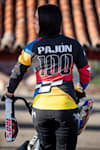When it comes to BMX racing, you cannot ignore Mariana Pajón. The 31-year-old Colombian rider is a two-time Olympic champion, an 18-time world champion and double World Cup overall champ. No wonder she’s been dubbed the ‘Queen of BMX’ by the media.
There’s a been lot of blood, sweat and tears along the way to achieving those impressive list of titles and the golden girl from Medellín isn’t quite finished yet either – Paris 2024 is just a year-and-a-half away and it’s full steam ahead as she looks to claim a third Olympic title.
Learn more below about Pajón as we take a look at her career to date, while also giving an insight into her personality on and off the bike.
01
Early beginnings
Being born in 1991, Pajón grew up in Medellín, a city that like most of Colombia was gripped by the violence exerted by the presence of organised crime in the country. Refuge for her parents from the realities of life came through sport. Her mother, Claudia, was a good horsewoman and swimmer, while dad Carlos competed in amateur motorsport events and on bikes. With such a sporty background, it was only natural that Mariana would also pick up a love for sport.
“I always wanted be to be like my father, I always saw him at car races, BMX races and mountain biking. He was very good, he won all the time,” recalls Pajón. “My older brother as well. I decided I wanted to be like them. My mother was also an athlete and she always knew I wanted to be one, like my parents. They were my role models.”
Pajón learned to ride a bike from the age of three and was soon being entered into BMX racing events. Due to the fact that there was no appropriate category for her age and gender – there weren’t enough girls in the sport – Pajón had to compete against five and six-year-old boys, demonstrating from the beginning the courage and determination that has characterised her career.
Apart from BMX racing, Pajón also liked doing gymnastics, but BMX won out in the end and was where she would concentrate her sporting endeavours.
02
Medical profession or bike pro?
Following age-related national titles, Pajón would go on to win an age-related world championships title at the age of nine. Her mother supported her developing racing career, but was also keen that she do well at school. Pajón was true to her word and did well despite the distractions of training (often twice a day as she got into her teens) and competing both nationally and internationally.
Pajón’s school years were coming to an end as she approached her late teens and she was faced with a decision on whether she’d go all out a pursue a pro cycling career as a BMX racer or pursue further education to become a doctor – a profession she felt she had a natural aptitude for.
Following excellent exam results, there was interest from Colombian universities if she wanted to pursue the long road of study to become a doctor, but in the end Pajón chose racing bikes. It was a decision that was very hard to make at the time and she admits to being conflicted. She even approached a university dean to seek advice about whether she could study and compete professionally at the same time.
“For me it was a green light to prepare with everything I’ve got for what I wanted to do in BMX.”
03
The only way is up
What probably made Pajón focus her mind on racing BMX was that success on the race track was happening regularly on the world stage. In 2008, aged 16, Pajón won the UCI World Championship in the Junior Cruiser category [BMX racing with 24″ wheels] in Taiyuan, China. A year later she defended that Junior Cruiser title in Adelaide, Australia, and also won the junior World Championship in the more regular 20-inch wheel category that would become the only wheel class for BMX racing post 2010.
A first senior title would follow in 2011 in Copenhagen, Denmark. With the Olympics happening the very next year in London she had a very real chance of taking a medal.
04
National pride in London
Pajón’s profile in her home country was building on the back of her successes at the World Championships. For London in 2012, she was chosen as the flag bearer for her country in the opening ceremony. A huge honour. The pressure was now on to perform, however. Her form going into London wasn’t the best, due to a series of injuries earlier in the year, but on the day of the final she managed to put that all aside. She took the lead on the first corner of the London race circuit and didn’t relinquish it to take gold – only the second gold medal in Colombia’s Olympic history. She was now a superstar in Colombia.
Pajón is without doubt Colombia’s most successful cyclist
© Maximiliano Blanco/Red Bull Content Pool
05
Nicknames galore
Pajón may have got the nickname the ‘Queen of BMX’ for being the most successful women’s BMX racer ever, but among the BMX racing community itself she is known as the ‘The atomic ant’.
The nickname was born from a race in the Netherlands in 2003, when the New Zealand BMX racer Sarah Walker was so amazed at the impressive skill and speed of Pajón, then only 11-years-old. Pajón has a very explosive drive and is known to aggressively attack courses, which she used to good effect when beating Walker to the gold medal in London in 2012. Pajón is just 5′ 2″ [1.57m] as well, so for her stature she packs a lot of power.
In Colombia, Pajón’s often called ‘Tata’ which comes from her older brother. When he was three-years-old it was really difficult for him to say, Mariana, so just called her ‘Tata’ instead.
06
Becoming world champ at home and a second Olympic title
The years that followed London continued to be filled with success. She became an elite world champion again, not just once, but four times. These included two time trial titles [the fastest time over the course] and two regular BMX race titles, the latter of which was on her home circuit in Medellín in 2016, a facility which is named after her.
Then came the Olympics in 2016. The World Champs in Medellin had happened just before Rio, so Pajón knew she was in good health and form. The added pressure here however was an expectant Colombian nation. She was also being backed at the Rio venue by a crowd that was overwhelmingly Colombian. Just like in London, she managed to lead into the first corner and kept her nerve to cross the finish line first and become a gold medal winner for the second time.
07
Superstitious Mariana
Talent may win athletes competitions, but try and tell athletes, many of whom believe superstitions, that. Pajón has a peculiar superstition – she has to wear different coloured gloves and socks
“One day I took the wrong socks and I became world champion, so I thought, ‘this could be the reason’. Since then, every race I run with different socks,” she explains.
It was with this strategy that Pajón won that first Olympic gold in 2012. At that race in London she raced with a white glove on her right hand and a black glove on her left, one black sock and the other purple.
08
Injuries take their toll
Despite her long run of success, not everything has run smoothly for Pajón. Staying resilient and overcoming obstacles has always been part of her story. Injuries are an inevitable part of being an athlete and Pajón has had her fair share. She’s had as many 18 fractures during her career, including nine screws and two plates inserted in her left wrist.
As someone who gives 100 percent her UCI career number is perfect
© Mathew Valbuena/Red Bull Content Pool
After tearing knee ligaments in 2018 at a World Cup race in the Netherlands, she had to stop competing for nine months, putting her participation in the 2020 Olympic Games at risk. She returned to racing in 2019, with the pandemic giving her an extra year to recover her strength and defend her two titles in Tokyo in 2021.
“I was one of the few athletes who really wanted that Games to be postponed, because it gave me time to prepare and be fully recovered.”
Sadly, there was no third gold. Pajón came second to Great Britain’s Bethany Shriever. There was still great joy for her however, with her silver medal a just reward for the hard work she put in since that 2018 injury.
09
It’s all go off the bike as well
The special ingredient in the triumphs of any athlete is not so secret: a massive dose of exercise, dedication and discipline, seasoned with a happy life full of adventures. Pajón certainly does that.
When not training or competing, she’s traveling the world alongside her husband and fellow BMX race pro Vincent Pelluard, enjoying hobbies and other sports. She loves to dive, surf and ski.
10
The future
Now 31, Pajón continues to put the hard work in. The motivation is to keep on winning, to be better the next day and maybe win a third Olympic title. She was once quoted as saying: “the future belongs to those who believe in their dreams” and her present approach to her sport underlies that.
She now varies her training with gym work, technical efforts on BMX race courses and has also added track cycling drills to her regime. And she keeps on winning. At the final round of the UCI BMX World Cup in Bogotá in October 2022, Pajón took the 13th UCI World Cup win of her career. If she stays injury free there could yet be more gold at Paris in 2024.
Part of this story












